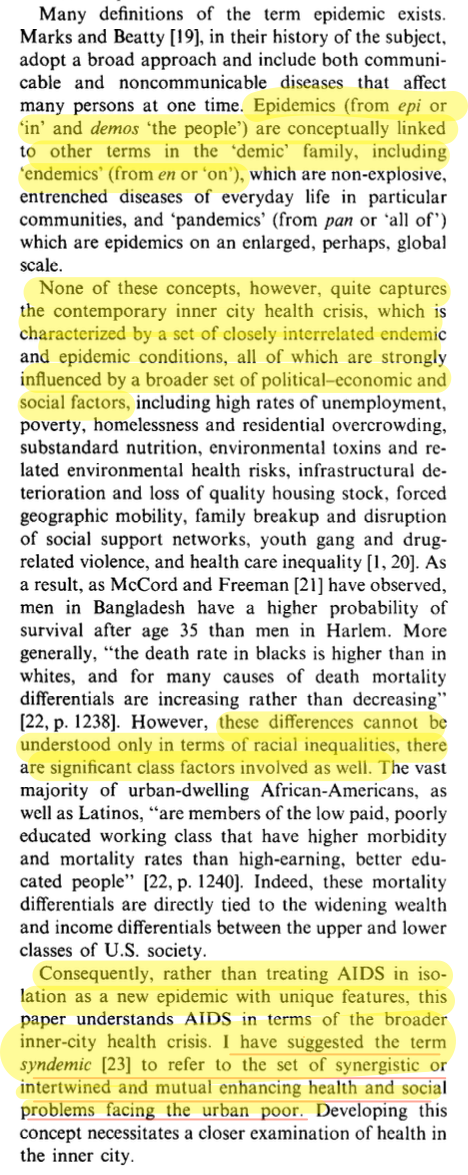By Lambert Strether of Corrente.
The scale of our ongoing, worldwide Covid pandemic is so enormous that it can be hard to imagine it’s part of a larger whole. For example, we might see outbreaks of measles or whooping cough as knock-on effects of mass Covid infection due to immune dysregulation, but we don’t really have a word to classify these outbreaks in relation to Covid. Generally, when I link to such a knock-on effect, I label it with the catchphrase “‘Tis a mystery!” and move rapidly along. This post is an attempt to introduce a little more rigor into the discourse by popularizing the term “syndemic.” The Covid pandemic, placed in relation to spikes of measles or whooping cough, would then be classified as a syndemic (although matters are not quite so simple, as we shall see). There are other syndemics, too, that are not related to Covid.
In this post I will first define syndemic (this is the “matters are not so simple” part), explain the origin of the term, present some candidates for syndemic status, along with the pandemic Covid and of similar scale, and conclude with a short discussion of the problems in deploying the syndemic approach.
Let’s start with the prefix, syn-: “From Ancient Greek συν- (sun-), from σύν (sún, ‘with, in company with, together with’).” Synaesthesia, synagogue, synthetic, and (verging on the woo) syncretic, synchronicity (woo), as well as (beloved of stupid money) synergy. When we place the Covid pandemic in relation to measles, a syn- word is therefore to be expected, in this case syndemic.
Interestingly, Professor Carpiano oversimplifies by erasing essential characteristics of the concept, as we can see by going to the source to which he links. From Cureus:
In a population with biological interactions, a syndemic is the accumulation of two or more concurrent or sequential epidemics, which significantly worsens the situation. Disease concentration, disease interaction, and . Extensive political, economic, and cultural factors have contributed to cluster epidemics of several infectious diseases, particularly HIV and tuberculosis.
Here is another overly simple definition:
Syndemic: A syndemic or synergistic epidemic is generally understood to be the aggregation of two or more concurrent or sequential epidemics or disease clusters in a population with biological interactions, which exacerbate the prognosis and burden of disease. (Wikipedia)
— Xabier Ostale (@xabitron1) May 11, 2024
Ostale, a Twitter personality, commits the same error as Carpiano (although in good faith, as the rest of this thread shows. Nevertheless, he defined the term as he defined it). Going to his source, Wikipedia:
Syndemics combine the synergies of epidemics to evaluate how social and health conditions travel together, in what ways they interact, and what upstream drivers may produce their interactions.The idea of syndemics is that no disease exists in isolation and that often population health can be understood through a confluence of factors (such as climate change or social inequality) that produces multiple health conditions that afflict some populations and not others.
Now let’s see how epidemiologists define and use the term; there seems to be no one defintion, and no one source, but all the definitions have a clear family resemblance. From the Lancet (2017, in an issue devoted to the topic):
The syndemics model of health focuses on the biosocial complex, which consists of interacting, co-present, or sequential diseases and the social and environmental factors that promote and enhance the negative effects of disease interaction. This emergent approach to health conception and clinical practice reconfigures conventional historical understanding of diseases as distinct entities in nature, separate from other diseases and independent of the social contexts in which they are found. Rather, all of these factors tend to interact synergistically in various and consequential ways, having a substantial impact on the health of individuals and whole populations. Specifically, a syndemics approach examines why certain diseases cluster (ie, multiple diseases affecting individuals and groups); the pathways through which they interact biologically in individuals and within populations, and thereby multiply their overall disease burden, and the ways in which social environments, especially conditions of social inequality and injustice, contribute to disease clustering and interaction as well as to vulnerability.
Nature (2022):
The theory of syndemics has received increasing attention in clinical medicine since the onset of the COVID-19 pandemic, due to the synergistic interactions of the disease with pre-existing political, structural, social and health conditions. In simple terms, syndemics are synergistically interacting epidemics that occur in a particular context with shared drivers. When policymakers ask why some communities have higher death rates from COVID-19 compared with other communities, those working from a syndemics framework argue that multiple factors synergistically work in tandem, and populations with the highest morbidity and mortality experience the greatest impact of these interactions.
Journal of Comorbidity (2024):
Syndemic theory recognizes that social factors create the conditions that support the clustering of diseases and that these diseases interact in a manner that worsens health outcomes. Syndemics theory has helped to facilitate systems-level approaches to disease as a biosocial phenomenon and guide prevention and treatment efforts.
BMJ (2024):
The increasing burden of non-communicable diseases, such as hypertension, diabetes and dyslipidaemia, presents key challenges to achieving optimal HIV care outcomes among ageing people living with HIV. These diseases are often comorbid and are exacerbated by psychosocial and structural inequities. This interaction among multiple health conditions and social factors is referred to as a syndemic.
Synthesizing, then, syndemic relates (multiple) disease clusters(1) to and through (multiple) social relations(2), (3).
Syndemic: Origin
From Encyclopedia, a trans-disciplinary journal, “Syndemic: A Synergistic Anthropological Approach to the COVID-19 Pandemic“:
We believe that we are living in a “syndemic pandemic.” The term “syndemic” was originally developed by the medical anthropologist Merrill Singer in the 1990s in order to recognize the correlation between HIV/AIDS, illicit drug use, and violence in the United States.
From Singer’s 1994 article, “AIDS and the health crisis of the U.S. urban poor; the perspective of critical medical anthropology“(4):

Syndemic, as we can see, has been completely erased as a lesson of the AIDS crisis by the public health establisment, very much including CDC(5).
Syndemic: Candidates
Candidates for recognition as syndemics include, but are not limited to, the post-Columbus Americas, post-Covid non-communicable diseases, monkeypox, antimicrobial resistance, and the Global South. Let us consider each in turn.(6)
The Post-Columbus Americas. From LibreTexts, “Syndemics and the Ecological Model“:
When Columbus “discovered” the New World in 1492, he unleashed one of the first waves of infectious disease that decimated Native American populations in the centuries to follow (Crosby 2003), eventually killing 90% of the population, an estimated 20 million people (Diamond 1997). The devastation of native communities was the result of a combination of factors. One was the very different histories of Europe and the Americas. With no history of animal domestication beyond dogs, turkeys, ducks, guinea pigs, llamas, and alpacas, Native Americans did not fall prey to zoonotic pathogens that produced highly contagious infectious diseases, leaving them with no resistance. Also, in spite of their profound differences in culture, language, subsistence, and political and economic systems, Native Americans were genetically very much alike (Crosby 2003). This was due to the small number of individuals who crossed the land bridge, which then closed, leaving them in genetic isolation for 10,000 years or more. This meant there was not a high degree of variation for natural selection to act upon in the midst of the severe evolutionary pressure of smallpox and other infectious diseases introduced by Europeans. Native Americans had also not benefited from the technological developments associated with warfare in the Old World, including steel swords, guns, and fighting on horseback, that had been perfected over centuries of conflict (Diamond 1997). European conquest also toppled existing political and social systems already crippled by epidemics of disease, leading to social disorder and cultural and economic disruption. To compound the situation, European colonization included the enslavement and forced labor of native populations to serve European interests, resulting in injury, starvation, and other mistreatment and leading to further loss of life. This complex of epidemiological, technological, social, political, and economic factors (a syndemic) combined to nearly exterminate Native Americans in the centuries following European contact, but this need not have been the case. Alfred Crosby (2003) points out that although epidemics among immunologically unprepared populations produce high mortality rates, some individuals survive, and the population will recover if left alone. He reminds us that Europe, for instance, lost one-third of its population to the Black Death in the fourteenth century and recovered in time. If the Black Death had been accompanied by the arrival of Genghis Khan’s hordes, miraculously plague-proof, the story would have been very different.
Post-Covid Non-Communicable Diseases. From the Lancet (2020), “COVID-19 is not a pandemic“:
The “science” that has guided governments has been driven mostly by epidemic modellers and infectious disease specialists, who understandably frame the present health emergency in centuries-old terms of plague. But what we have learned so far tells us that the story of COVID-19 is not so simple. Two categories of disease are interacting within specific populations—infection with severe acute respiratory syndrome coronavirus 2 (SARS-CoV-2) and an array of non-communicable diseases (NCDs). These conditions are clustering within social groups according to patterns of inequality deeply embedded in our societies. The aggregation of these diseases on a background of social and economic disparity exacerbates the adverse effects of each separate disease. COVID-19 is not a pandemic. It is a syndemic. The syndemic nature of the threat we face means that a more nuanced approach is needed if we are to protect the health of our communities…. A syndemic is not merely a comorbidity. Syndemics are characterised by biological and social interactions between conditions and states, interactions that increase a person’s susceptibility to harm or worsen their health outcomes. In the case of COVID-19, attacking NCDs will be a prerequisite for successful containment.
Covid’s vascular and neurological sequelae, then, can be reconceputalized from “knock-on effects” to components of a syndemic.
Monkeypox. From HIV.gov (!!) (2022) “Addressing Monkeypox Holistically“:
From day one of the Biden Administration’s response to the Monkeypox outbreak, we have recognized that Monkeypox is not a virus that lives in isolation. It exists as a part of a number of acute and chronic outbreaks and health challenges that interact with each other and can be impacted by social circumstances that worsen disease outcomes. Such interacting epidemics, or ‘syndemics,’ require responses beyond traditional disease-specific healthcare delivery and to also address associated social determinants of health. That’s why we have worked closely—and successfully—within the Administration and with our partners in public health, the LGBTQI+ community, and with community-based organizations—to combat and treat this virus using a holistic approach, that takes all of these factors into consideration.
HIV and Monkeypox are examples of syndemic outbreaks that interact with each other and therefore require specific action for both diseases in order to mitigate the impact of both. Recent epidemiology has shown that people with HIV continue to be over-represented in cases and severe manifestations of Monkeypox disease. In one study published by the CDC, nearly 40% of people diagnosed with Monkeypox had HIV infection, and over 40% had been diagnosed with a sexually transmitted infection (STI) in the year prior to their Monkeypox diagnosis.
Syndemics are not just about viruses and bacteria; social circumstances like systemic inequities in the health care system and social determinants of health like housing interact with infections to worsen or deepen their impact. In this same report of severe Monkeypox outcomes, nearly 70% of patients were Black and 23% were experiencing homelessness.
Too bad the Biden Administration doesn’t apply the same thinking to Covid.(7) Wrong silo, I guess.
Antimicrobial Resistance. From the Center for Infectious Disease Research and Policy, “Report highlights role of socioeconomic, sociocultural factors in antimicrobial resistance“:
A policy brief published yesterday by the European Observatory on Health Systems and Policies suggests antimicrobial resistance (AMR) policies need to take socioeconomic and sociocultural factors into account.
The brief notes that while efforts to understand AMR have focused on the biomedical model, interactions between socioeconomic and sociocultural determinants of health and AMR, particularly in low- and middle-income countries, have not been studied extensively. Among the factors the authors highlight are gender, living situations, healthcare access, educational access, poor governance, mobility, conflict, and climate change.
Although how these factors contribute to the spread of AMR are complex, the authors say that understanding them could inform development of interventions. Such interventions could address, for example, why women are more likely than men to experience exposure to drug-resistant infections and be prescribed antibiotics, why people in urban and overcrowded environments are associated with a higher risk of AMR, how limited access to healthcare can result in more inappropriate antibiotic use, and how human mobility and conflict can lead to the introduction and spread of new strains of drug-resistant organisms.
The term is not present, but the concept is.
Global South. From BMJ, “Guinea’s response to syndemic hotspots“:
The Guinean health system has been severely overstretched this year. It has to deal with several concurrent (re-)emerging infectious diseases—Ebola, Lassa fever, measles, meningitis, yellow fever, vaccine-derived poliomyelitis—as well as a second wave of the COVID-19 pandemic. A case of the highly infectious Marburg viral disease was also detected in August.
These multiple concurring epidemics reflect contextualised ‘syndemic hotspots’ whereby (re-)emerging infectious diseases, existing socioeconomic inequities, a fragile health system, chronic malnutrition and security constraints interact and cluster in marginalised and impoverished populations. At the same time community resistance has been observed against the epidemic control measures (related to the Ebola virus disease (EVD) and COVID-19, mostly) across the country. This had implications on population health, among others through injuries and deaths as a result of police intervention. This securitisation of epidemics response almost inevitably deepens community mistrust in public services, aggravates social inequalities and hinders efforts to combatting ongoing epidemics in the country. This syndemic situation is not unique to Guinea and is observed in many other countries, and specifically in countries with similar socioeconomic and health system constraints such as DR Congo. The ecological reservoir for lethal emerging diseases like viral haemorrhagic fevers has expanded in recent years. The risk that multiple epidemics occur at the same time in the nearby future is high in countries like Guinea, DR Congo and others. The potential for international expansion, and thereby for longstanding chronic ‘syndemic hotspots’, is considerable because of economic globalisation and the international trade nexus in which West and Central Africa play a role.
For grins, here’s a big list of other candidate diseases:
Growing list of viral and bacterial pathogens with epidemic potential of concern at 2024 mass gathering events:
Viral pathogens
•Crimean–Congo haemorrhagic fever virus
•Ebola virus
•Marburg virus
•Lassa fever virus
•MERS-CoV
•SARS-CoV
•SARS-CoV-2
•Nipah virus and…— Hiroshi Yasuda (保田浩志) (@Yash25571056) May 16, 2024
Conclusion
I think that, conceptually, syndemic theorizers have got hold of the right end of the stick (and everybody running our response to the Covid pandemic have got hold of the wrong one). My concerns are that although epidemiology is hard, syndemic investigation looks to be an order of magnitude harder. Merrill Singer was a medical anthropologist; are we really going to need an army of Trisha Greenhalghs and David Graebers to move forward? With nimrods like the Brownstone Institute fighting them tooth and nail, not to mention the so-called public health establishment? JAMA suggests some of the difficulties in “Applying Syndemic Theory to Acute Illness” (2021):
Acute health conditions exist within complex, community-specific, syndemic relationships. To leverage this insight and convert it into actionable improvements in the prevention and treatment of acute health conditions, medical and public health communities should employ the following steps:
- Identify the fundamental social and biological conditions involved in the complex systems of acute illnesses within specific contexts of place and time. This will require linking multiple individual- and community-level data sources. Administrators of major health plans and state and federal government agencies will be essential in facilitating this type of data linkage and in fostering data access and collaboration. Clinicians have an important role in working with patients to identify the key social and biological processes affecting their patients’ health.
- Evaluate key relationshipsbetween and among these conditions, including causal mechanisms and feedback loops, using community-informed research methods. Multilevel modeling is a well-established approach for the evaluation of syndemic relationships. Agent-based modeling, a simulation model in which outcomes are determined by the local actions and interactions of agents within an environment, and geospatial analysis may be particularly helpful methods. Researchers and clinicians must collaborate across disciplines and traditionally siloed fields of medicine to assess important disease-disease interactions.
- Investigate ways to shift the complex system of risk factors and forces that influence acute health conditions, and introduce new ways of thinking about prevention and intervention. These evaluations may reveal that prioritizing key elements of the system could have significant downstream effects on other components without having to address them all at once, with some elements essentially acting as levers or blockers. Through new research and community collaborations, it may become clear that a seemingly ineffective intervention tested in one population or with one outcome may actually be effective when tested in a different set of circumstances.
Syndemic frameworks can help identify or improve the efficacy and efficiency of new medical or policy intervention and can be powerful tools for social justice in health.
That’s an big agenda with enormous policy implication, and I doubt very much JAMA has the leverage to achieve it, important though clinicians are. Take this one sentence: “Administrators of major health plans and state and federal government agencies will be essential.” So we’re doomed then? CDC is opposed to “data linkage”: It doesn’t track positivity, has shut down mandatory hospital reporting, does not emit timely data on deaths — and remember that hospitalization and deaths, not infection, are the only numbers CDC cares about — and has corrupted and polluted the wastewater reporting system. And those “elements essentially acting as levers or blockers.” Like, for example, profit?
The problems of political economy are the problems of the political economy itself. My thought, given the evident correctness of syndemic conceptually, is that most JAMA’s research program can be taken as read — for example, we don’t need any more studies to know we need to clean the (family blogging) air, not least because the rich are already doing it for themselves. Perhaps we need to do less “agent-based modeling,” and more work with actual agents?
NOTES
(1) Some defintions went with pandemics; I went with clusters, since clusters might grow into pandemics.
(2) I would expect “social determinants of health” discourse to overlap with “syndemic” discourse, but it seems not to. But perhaps I haven’t done enough reading.
(3) Note that in the above quotations, The Lancet (2017) adds “environmental.” The others (2022 and 2024) do not. Treating environmental factors as distinct from social relations might, given the dominance of private property, be seen by some as problematic.
(4) I cannot find an online copy of the 1992 Singer article cited in footnote (23) in the Journal of Health Care for the Poor and Underserved, “Generations of suffering: Experiences of a pregnancy and substance abuse treatment program,” where apparently the term was coined)
(5) Here is the result of a search on “syndemic” at CDC’s site. The CDC-coined neologism “tripledemic” — Covid, RSV, flu — could be regarded as an erasure of the very concept of syndemic, since it considers only diseases in isolation; even leaving aside social factors, “tripledemic” fails to consider the possibility that immune dysregulation from Covid renders infection by RSV and flu more likely. (Of course, the concept also implies that Covid is seasonal, which is false.)
(6) I wish I could include measles, but the only article is paywalled.
(7) I would speculate this rational, as opposed to sociopathic, approach is a testimony to the continued strength of AIDS activism.






